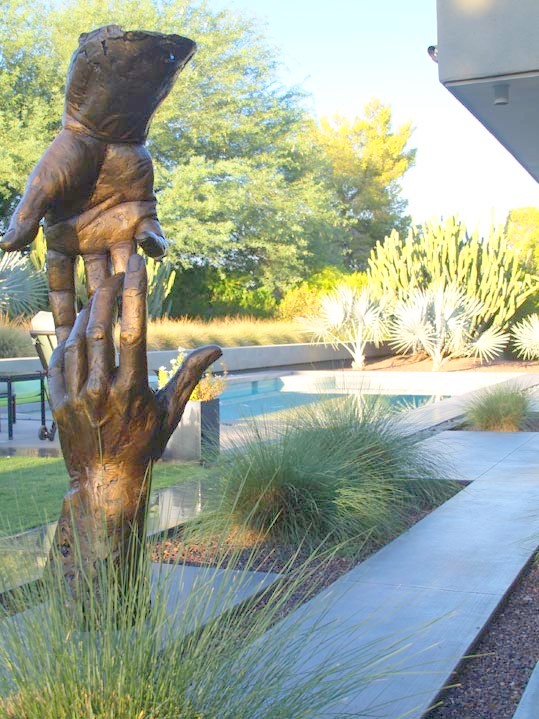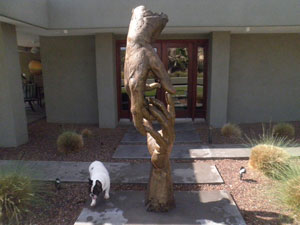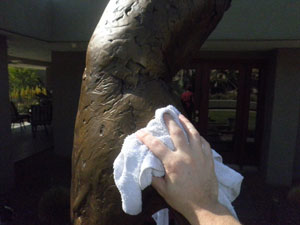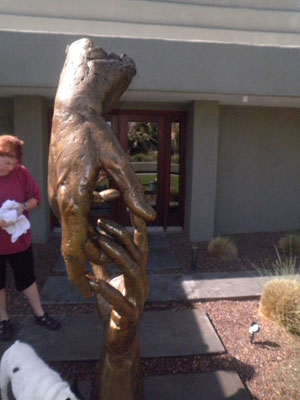
One of your biggest enemies in building strong relationships with collectors is time. Your customers may never stop liking you and your work, but they may instead do something far worse: stop thinking about you.
Of course, there are ways to prevent this. Marketing is as much about retaining former customers as it is about gaining new ones. So keep at your newsletters, your postcards, your open-studios – whatever it takes to stay in front of your buyers. We all know, however, even the best marketing can start to get stale after a while.
Want to do something that will put you both front and center in a collector’s mind and generate a boatload of good will? Try this:
Pick up the phone today and call a past customer.
“Hi, this is _______________, you purchased a piece of art from me called _________________ about 18 months ago (or however long it’s been). It’s about time for the piece to be cleaned and I wanted to set up a time that would be convenient for you when I can stop by and do some basic cleaning and maintenance on the piece. It will only take about fifteen minutes, and there’s no charge, what does your schedule look like later this week?”
I’ve called clients with this approach in the past and the response has been excellent. I’m not doing this as an overt pitch to make sales – that’s really not what it is – I just want to provide excellent customer service to my clients and I want them to think about me the next time the urge to visit a gallery strikes.
I remember that one customer I called was thrilled with the offer but wanted to know how much it was going to cost him – when I told him there would be no charge he was shocked – I think he must have said “thank you” about a dozen times.
While this obviously works best with local clients, as you travel you can look for opportunities to visit with out-of-state clients.
A dust rag and a can of compressed air (from Costco) while wearing white kid gloves ought to make the process look technical enough. If you can, take the painting off the wall to check the wire as well.
Try this and let me know what happens!
Service, Service, Service!
Photos from an Outing to Clean a Gary Price Sculpture



This is an excellent idea.
Back when I owned an art gallery, I used to do a similar thing with great results. Each time someone purchased a painting I would make a note to call them back in six months. At that time, I would let them know that their painting needed to be brought in (or picked up by me if feasible) for the final varnish.
This re-connection often led to a series of events that ended in another art sale.
It’s also a great thing to do because it’s not solely for marketing purposes, although that’s a fantastic side-effect.
In fact, the final varnish is critical for oil paintings and often can’t even be applied for six months after the painting is completed (or even a year in some cases). In today’s fast-paced world where everyone needs results and sales today, most artists can’t afford to wait the six months,let alone a year, to apply the final varnish and the ship the painting to the gallery. So lots of paintings end up being sold without the final varnish. (note: the final varnish is NOT the temporary liquin that CAN be applied immediately to give an oil painting that glossy, varnished look – that will wear off).
I may be telling you something you already know, but a quick story: The varnish on an oil painting serves the same purpose as the glass on a watercolor – protection. I became a full believer in this when one of our customers had a house fire which luckily was put out before the house burned to the ground, but it did cause a lot of smoke-damage to their extensive collection of oil paintings. Out of desperation, they brought the paintings to the gallery – I would guess around 50 oil paintings – and the pieces looked like someone had framed 50 black canvases.
I didn’t have high hopes.
We took the art to a local art restoration expert. And amazingly, she was able to completely save every single painting. And she told us why: A few months earlier we had contacted this particular couple and offered to varnish all of their oil paintings. The restoration expert told us that the varnish had saved the paintings. All she had to do was strip the varnish off and the paintings themselves, perfectly protected, were in pristine condition. All we had to do was apply a new coat of varnish.
Wow – that is a fantastic story! And something I never knew. Thanks!
Great story, and I was just mentioning this issue to Jason re the wait to varnish paintings. (6 months to a year) as difficulty in terms of quality of the work. I sometimes ship paintings unvarnished and worry about how they will stand up in just such a case.
However, the information I have received from conservation experts is never to use liquin as a final coating or isolation coat. It can be mixed with paint during the painting process if desired, but never apply a coat as a temporary varnish. It yellows, and cannot be removed like varnish can. (MISTRA University of Delaware, conservation science)
Varnishes I have used are Gamvar, and Golden MSA varnish both are designed to be removed. You can also use dammar varnish, but some people don’t like the gloss. Always test first on a scrap painting.
If you want a clean glossy finish, you can apply a Laropal resin varnish first, as an isolation coat and then a regalrez resin varnish last (Gamvar) Thinner is better than thick. Gamvar can only be applied as one coat. Be careful with flat varnishes, the silica (the flattening agent) tends to sink to the bottom and create streaky results.
What a great idea! Wonderful way to keep in touch. Thanks for the suggestion!
Shirley Bland
Fabulous idea! I will be trying this on my customers and recommending to my artist friends to do the same. Making a personal visit to collectors is so important — email newsletters just aren’t enough!
Best,
Arlissa Vaughn
CEO & Founder
Visual Overture Magazine
http://www.visualoverture.com
Excellent story, Clint!
Sold me on the need to do that final varnish.
What formula did you use for that final varnish?
Does this hold true for Acrylic paintings as well? If so, what particular formulas should we artists use?
Thanks! Donna
Curious to know what varnish you recommend. Most of my paintings were sold without varnish and think this is an excellent idea. Thanks!
I love this idea and have been amazed at how collecting works, with several of my collectors purchasing multiple pieces. They are all soft pastels framed with museum glass. Not sure how I might offer to “clean” the work. Any ideas?
I am guessing that after a time pastel particles would dislodge and end up settling on the mat edge or in the bottom if you don’t use a mat. I have several pastel paintings that this has happened to. It would be a lot of work to take it out of the frame and clean that off and clean the inside of the frame. But that would be the way to clean it.
Hi Linda and Mary. I’m a pastelist, and I’ve taken many of my paintings out of their frames and cleaned the insides of the frames and the glass, and re-framed the painting. It’s not really that hard, since I don’t use mats, just spacers. I also use AR museum glass (anti-reflective, not that nasty ‘non-glare’ stuff), and it can be ruined by improper cleaning. I use only microfiber cloths lightly dampened with plain water for the glass. The AR coating can be damaged by using cleaners containing ammonia, which most glass cleaner does contain. I also truly hate paper backing on paintings, so I don’t have to worry about getting that stuff off and back on again. I use either museum board or archival foam board to back my paintings, which is also easy to clean and touch up if necessary. I do this not only for my collectors, but also after each gallery show. It’s just part of the deal! Hope this helps.
How do you attach the board so that it easily removes?
One way is to use brads and a brad setter or a light hammer. Another way is to re-use those diamond points.
Both are easily pulled out with needle-nose pliers, and can be pushed back into place with those same pliers or any flat metal and a thumb when you replace the backboard. Just be sure they are snug against the edge of the board; neither has to lay flat.
I love this idea of cleaning the art work. Only I do collage that is framed under glass so what can I do? Thanks. Patricia
how about checking the backing for tears (may need replacing or even a patch can tidy it up – I use carefully cut paper tape that you wet to adhere on brown paper dust covers) how’s the wire, clean the frame (polish, dust?) clean the glass. It may be things they could do, but to be done by a professional, ooo la la. Makes a statement no matter what is done. Oh, and don’t forget the white gloves! They impress and make a statement about the value of your art!
I try to varnish every painting also however some collectors cannot be convinced of why this is so important and recently I sold 9 of my best paintings to a big collector that just did not want me to do it!
Thanks for the article as a reminder to us all to remember to do this!
I live in a community in eastern Washington that has managed to hold on economically so far. However the artistic culture is a bit sterile. Recently I leased a studio offering inexpensive spaces and they are not nearly all rented. Population is approximately 200,000 metro wide. We have an airport, major highways, colleges, etc. There is some local art community endeavors but the area is not thriving. “Sterile” is a word I used but heard from this new group trying to start some juice flowing here. I am looking for ideas to jump start, create, stimulate the local community. You can go to Spokane, Seattle or Portland and find the pulse in the arts. Help and advice? I have bought your book and awaiting delivery. Look forward to your comments.
Cecelia
You could start a one or twice a month “pub evening” with the artists you do know with the intent of discussing the wins and loses of what you all are working on and ways of going from “starving” to successful. Publicizing invitations, in local coffee shops for instance, could be a starting point to developing a Left Bank vibe in your community.
Enthusiasm is contagious.
Jason, this is brilliant! I think you are setting a new standard and a good one at that. The best way to ensure the proper ongoing care of my work is to do it myself. In the process I am impressing my client with how I value them and the work they invested in. This is why I like you. You have the Best Ideas.
I like that. Here’s a question on that. I live in ca. And I have a client on Cape Cod Ma. They purchased a welded metal wall sculpture of an eye. The piece went through a house fire and needs restoration. Is it reasonable to ask them if they pay for shipping here and back that I will provide a free restoration?
Pierre, I would offer free shipping and charge for the restoration. Their insurance will cover that.
That’s a terrific idea and I’m sure very much appreciated by your collectors. Totally off topic, I just wanted to say how much love the sculpture. It’s absolutely gorgeous!
Great idea Jason, as an artist/custom framer, I’ve seen it all and I do witness the neglect and abuse art and framing endures. I’m turning one of my blogs towards all this. Gave this a thought years back, on maintenance of my sold works, but it slipped through the cracks. Thanks, for re-igniting the thought. You’re so right, Service-Service
Wow,love the idea on reconnecting with past clients. Though i’d have problems with distance, but i think calling at least is a good start. People love it when we care enough about them
Is there are varnish that doesn’t turn yellow on a oil painting years later? And I’ve heard that you should wait a year or six months after the painting is finished to varnish. To make sure the oils are dry & especially when it’s painted with palette knife. The oils can be applied very thick & would take longer period to dry.
I have not varnished my paintings for years.
Pertaining to restoring oil paintings…I have a customer who doesn’t use air conditioning year round. One of her paintings is getting mold spots on the back of the canvas. What is the best way to restore the painting? Will this affect the painting’s worth?
What a great idea! Your post is very timely! I had recently been wondering how to keep in touch with out of state collectors. The idea came to me about sending a note along with a soft rag and explaining the cleaning process to the collector. I paint with acrylic and usually just use plain water and a soft cloth to clean my paintings. One of the commissioned paintings I recently painted, I delivered it with the understanding that in two weeks I would need to take it back to put the final varnish layers on. I think the collector loved this idea. She even called me when I didn’t respond in exactly two weeks. It was another way to have a face-face with my collector.
What kind of varnish do you use on acrylic?
There are both removable and non-removable varnishes available for acrylic. Liquitex makes a non-removable one and Golden has a two step process for acrylics involving an isolation coat and a polymer removable varnish. I have used both and both look good. The removable one would be more helpful in the case of smoke damage!
To Rita Sklar:
For my acrylic paintings, after they dried, I apply a coating of acrylic gloss medium and varnish.
For oil paintings, you can use Winsor and Newton Griffin Picture Varnish, which is non-yellowing, and recommended by a conservator.
Anyhow, hope that this helps with your choices.
Great advice. However, my clients own framed watercolours or Giclee Prints. Any ideas???
Thanks
We have cleaned framed work under glass for clients and done “wire checks” (checking to make sure the hanging wire is stable). Be creative, think of an excuse to get into the home and provide a service, no matter how small.
Jason I love what you said about cleaning paintings. Do you have any suggestions for Photography under glass or plexus glass or images printed on canvas?
Instead of cleaning the oil painting with fake air spray and gloves or dusting it, offer to Damar varnish the painting a year later; that’s what I do with patrons who have major works and are still communicant with me. If the price is right I usually can place a half-dozen pieces with one interested collector.
Thank you. Great advise.
Thanks for another great article Jason. I think this seems to put the many types of galleries out there in some easy to understand categories to make decisions about them from.
Love this idea! And as a few have already said – you have the BEST ideas. I will be starting this with my current clients as well, though cleaning stained glass is mostly about getting rid of the dust.
thank you!
What a great idea! I’m a fiber artist making art quilts which essentially means I’m creating wall hangings by “painting” with fabric and thread. Although I give my clients instruction on cleaning when they buy the new art piece they are often afraid of damaging the piece. Your advice will bring me back to my clients in a way that shows that I care about them and my art. Thank you!
Great customer service tip. I would however be mindful and cautious about cleaning pieces without proper knowledge of the medium. Knowing the medium(s) used and carefully examining the piece is essential. At times I don’t believe a simple dust rag and can of compressed air wears well on everything.
I put my name, the title of the piece, the medium and varnish used…in pencil on the back of my canvases. I never try to sell any work I haven’t varnished. I’ve had to clean oils after a fire and it would have been useful to have had that information handy.
I had experience cleaning pastels, but never anything else behind glass.
Great idea. I paint acrylic o. Wood panel then finish the surface with a gel , then sand that down and apply a cold wax and polish.
When I sell a work I give people a lint free cloth to wipe it and keep it clean.
I will have to reconnect with them to offer an inspection or cleaning. Love the white glove idea and wiring inspection.
As asked above by several people – please recommend a varnish for oils that does not yellow over time.
While I am on the subject of oil painting do collectors like or dislike paintings that are water-soluble oils or do they prefer the tried and true oils? Also will a varnish work as well on water-soluble oils as the standard oil?
Thank you
Hi Marcy,
Gamvar is a good readily available varnish, and Golden sells a MSA varnish (it has to be mixed with their solvent, read the label and check website) that are both good and non-yellowing and can be removed for cleaning or restoration. Damar can be used, but there might be some yellowing. Test first to see what you like, unfortunately that’s the best way to decide which product you like. Natural Pigments might sell a sample kit so you can try some varnishes out. Gamvar comes in small bottles and golden technical dept. might sell you a small amount to try if you contact them.?
Once the water evaporates from water miscible oils they are ‘oil’ paints. So once the paintings are good and dry (ideally 6 months to a year) you can treat them as oil paintings and varnish with the oil varnish of your choice.
Jason, I’m new to your blog. This is an amazing idea. Clients will love this, it shows that you remember them and you value them.
Thank you
Etheard.
Jason! A stellar idea for the client and the artist Thank You!
I had the pleasure of doing this exact thing for a friend who commissioned me for a beach scene. They were thrilled with the painting. I offered to come back in six months and varnish which she followed up on. The piece was acrylic and could have been varnished sooner but she was anxious to hang the painting in her newly renovated home. So I came to her home 6 months later and what a beautiful difference a coat of varnish makes on an acrylic painting. She was so happy she gave me a great review and pic on my fb page. Pays to show appreciation for your customer and value your art as well !
Great idea Jason, thanks!
I paint watercolors and am a newbie to selling work. My comment is 2 fold. I’ve seen some W/C artists adhering their paintings to gator board and using multiple layers of acrylic varnish to seal them so they need not go behind glass. Be tried it and it’s very time consuming and I’ve ruined some pieces. ( I chalk that up to a learning curve.). But even with 6 layers of varnish, I can still scratch the surface. Is there a curing time? Also is there a product other than gator board I could use? It’s so very difficult to cut to size. I’ll take any advice for W/C. Thanks.
My next comment is another reconnection idea. I worked as an apprentice for a wonderful artist years ago. He had a deal where people could trade art if what they have isn’t working for them. They’d pay the difference on the new piece. Not many wanted to trade but I have a piece of his and always loved the idea that I could trade if need be.
As a restorer of art as well as an artist i do this regularly and in addition to simple cleanings to their other art at same time. [subject to the limitations of value and liability. ]
Hi Richard,
What do you recommend for cleaning paintings? ie run of the mill simple cleaning, not what you would do professionally
Great idea. I originally learned this in a Daniel Greene Portrait workshop but forgot as I was doing pastels at the time. Now I’m doing oild so will initiate this.
Great suggestion!
You are always providing us with tremendous useful material and new ideas about our art practice.
Thank you!
Beatriz
WOW Jason…you just keep the idea coming!!! Thank you 🙏
Thank you for your suggestion to offer a cleaning for my oil painted portraits. I have several works at my client’s magnificent home and am presently working on a new large double person commission. I do not offer frames for my commissions, however, I’m happy to help them select a proper frame. Please let me know if you suggest my removing the frame (or having the framer remove the existing frame) before applying the FINAL varnishing. It seems to me that this would be most desirable (and common-sense), however, my clients may be apprehensive about me doing so! Please let me know your thoughts!